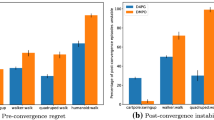Abstract
Humans can generate accurate and appropriate motor commands in various, and even uncertain, environments. MOSAIC (MOdular Selection And Identification for Control) was originally proposed to describe this human ability, but this model is hard to analyze mathematically because of its emphasis on biological plausibility. In this article, we present an alternative and probabilistic model of MOSAIC (p-MOSAIC) as a mixture of normal distributions and an online EM-based learning method for its predictors and controllers. A theoretical consideration shows that the learning rule of p-MOSAIC corresponds to that of MOSAIC except for some points which are mostly related to the learning of controllers. The results of experiments using synthetic datasets demonstrate some practical advantages of p-MOSAIC. One is that the learning rule of p-MOSAIC stabilizes the estimation of “responsibility.” Another is that p-MOSAIC realizes more accurate control and robust parameter learning in comparison to the original MOSAIC, especially in noisy environments, due to the direct incorporation of the noises into the model.
Similar content being viewed by others
References
Welch RB, Bridgeman B, Anand S, et al. (1993) Alternating prism exposure causes dual adaptation and generalization to a novel displacement. Perception Psychophys 54:195–204
Wolpert DM, Kawato M (1998) Multiple paired forward and inverse models for motor control. Neural Networks 11:1317–1329
Sato M, Ishii S (2000) On-line EM algorithm for the normalized Gaussian network. Neural Comput 12:407–432
Kawato M (1990) Advanced neural computers. North-Holland, Amsterdam, pp 365–372
Haruno M, Wolpert DM, Kawato M (2001) MOSAIC model for Sensorimotor learning and control. Neural comput 13:2201–2220
Author information
Authors and Affiliations
Corresponding author
About this article
Cite this article
Osaga, S., Hirayama, Ji., Takenouchi, T. et al. A probabilistic modeling of MOSAIC learning. Artif Life Robotics 12, 167–171 (2008). https://doi.org/10.1007/s10015-007-0461-9
Received:
Accepted:
Published:
Issue Date:
DOI: https://doi.org/10.1007/s10015-007-0461-9




